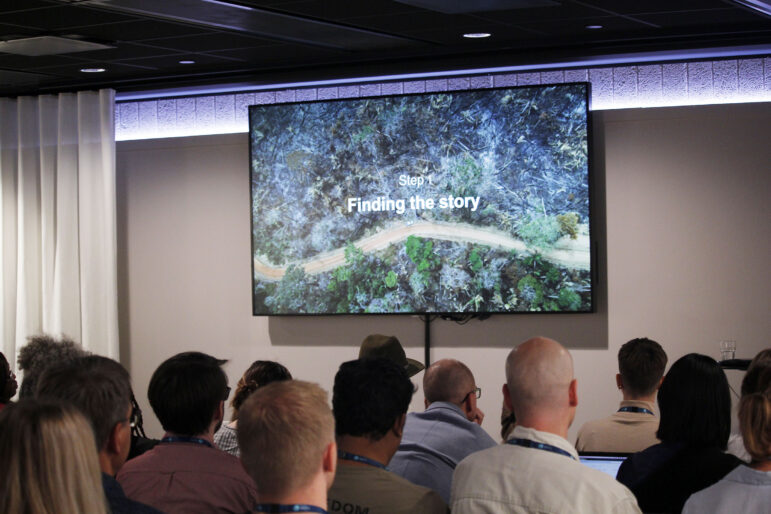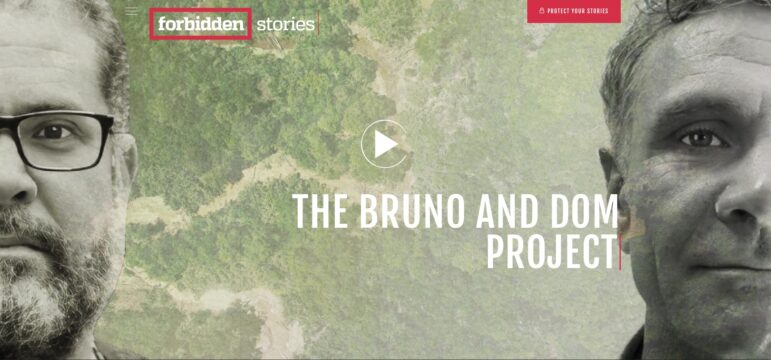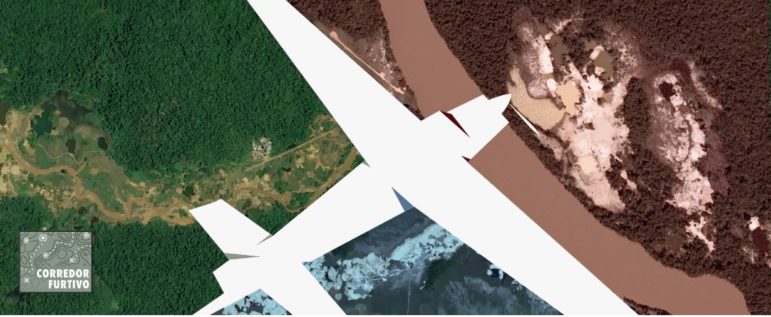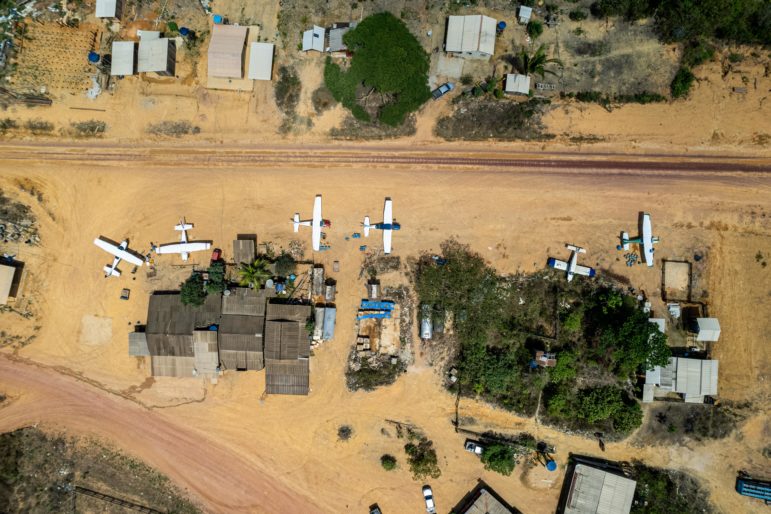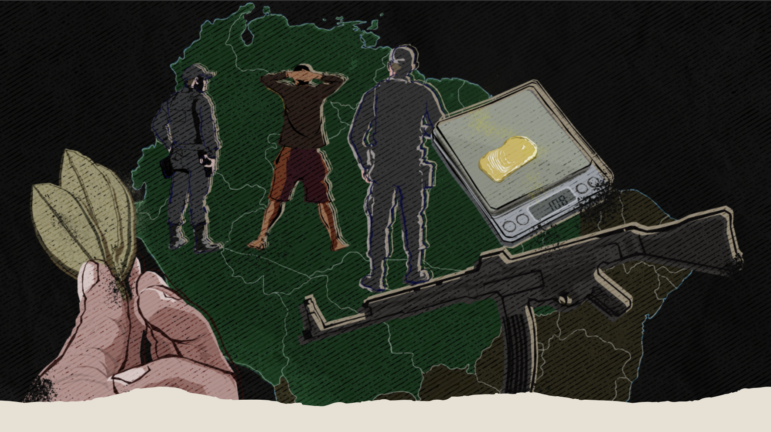

Illustration: Screenshot, Amazon Underworld/InfoAmazonia
How They Did It: Investigating Organized Crime Networks in the Amazon Rainforest
The Amazon rainforest harbors an underworld network of criminal economies that range from drug and wildlife trafficking to illegal mining, fishing, and logging.
Although these activities have been taking place in the Amazon rainforest for at least two decades now, three factors have recently exacerbated them: the COVID-19 pandemic, which lowered the budget states had available to improve security and oversight in the region; former Brazilian President Jair Bolsonaro, who tacitly supported deforestation and land grabbing and was indifferent towards illegal activities in the Amazon; and the failed implementation of Colombia’s 2016 peace accords, which atomized the FARC guerrillas into a myriad of criminal transnational networks.
Journalists and civil society organizations received a brutal wake-up call about the extent to which the Amazon has been occupied the underworld when the Guardian correspondent Dom Phillips and Indigenist Bruno Pereira were murdered in 2022 in the Javari Valley, an area in Brazil that borders Peru and Colombia.
“The deaths of Dom and Bruno were a tipping point for journalists. We never thought the Amazon was a conflict region. We never thought it would be dramatically more dangerous for journalists to conduct work in the Amazon than in other areas notorious for violence,” said Bram Ebus, an investigative journalist who has more than a decade of experience reporting from all the different countries that compose the Amazon basin.
Currently, Ebus is the lead journalist and investigative coordinator of Amazon Underworld, a large-scale journalism project that aims to reveal the extent to which organized crime controls a region that is nearly devoid of governance, either because of institutional weakness or wilful neglect. “For me personally, [their murders] were not something that made me pull back, but underlined the need to continue journalistic work in the Amazon, because security dynamics are escalating, and violence is exacerbating,” Ebus explained. “Instead of taking one step back, we need to double down on these issues.”

Landing page interactive illustration for the Amazon Underworld project, a large-scale collaboration that features eight interconnected investigations. Illustration: Screenshot, InfoAmazonia
Amazon Underworld is a web of eight interconnected investigations that has, at its core, the most rigorous, comprehensive, and user-friendly mapping of armed groups throughout the Amazon. It is published by GIJN member InfoAmazonia, in collaboration with Colombia’s La Liga Contra el Silencio and Venezuela’s Armando.info, also a GIJN member.
More pieces will be added to the ones already published by the project, which includes a report on illegal gold dredging in the rainforest’s rivers, an investigation into the armed groups (most of them from Colombia) that threaten Indigenous communities in the Venezuelan Amazon, a report on the coca pickers and cocaine producers along the Peruvian border with Brazil and Colombia, a piece about how drug runners use shamans for protection, an investigation about how a Brazilian gang operates in the Peruvian Amazon, a report on the forced recruitment of Venezuelan Indigenous youth by Colombian guerrillas, a piece about the plight of Venezuelan migrants at the hands of criminal groups, and an investigation about how drug gangs threaten communities in the Amazon’s cocaine corridor.
In total, 37 people from 11 countries worked on the nearly 18-month-long investigation, which spanned from March 2022 to July 2023. This team included freelance media professionals and staff from partner organizations, editors, fact-checkers, security experts, and Indigenous photographers and translators. No team of journalists this large or this diverse had ever worked together to understand and explain transnational criminal activities in the Amazon.
“We wanted to do an interactive, collaborative media project and before we knew it, we were basically laying the infrastructure for what could resemble a media organization, because we got so many people involved,” said Ebus, who was a fellow with the Pulitzer Center’s Rainforest Investigations Network and who applied for funding from the Open Society Foundations, the IUCN National Committee of the Netherlands, and the British Embassy in Bogota through the Foreign Commonwealth & Development Office.

Bram Ebus, lead journalist and investigative coordinator of Amazon Underworld. Image: Screenshot, Twitter/X
At least 20 reporting trips were conducted in Brazil, Colombia, Peru, and Venezuela, especially in border regions, because the focus of the project was the cross-border nature of organized crime in the Amazon region. “We thought most of the stories should have a cross-border element, where at least there’s a criminal group that crosses the border or an illicit economy that overlaps the territories of two countries. We also wanted to make the case that borders don’t exist for organized crime in the Amazon region,” Ebus explained. Thanks to a small grant the team received at a later stage, Bolivia and Ecuador were eventually added to the crime group mapping.
The challenges faced by the Amazon Underworld team demanded a wide range of expertise, from traditional reporting to data journalism to programming. Reporters from Brazil, Peru, Colombia, Ecuador, and Venezuela conducted in-depth interviews on the ground to determine detailed and even intimate angles for their stories, such as the personal motivations of the people involved in the criminal networks.
“Journalists spoke to people that belonged to crime networks because we wanted to step away from the usual environmental journalism that consults environmental experts and community leaders,” Ebus said. “We wanted to understand who the perpetrators were and why they are often destroying their own natural surroundings. So we chose to work with journalists that have a lot of empathy with the sources, who are good at fieldwork, and who are witty enough to go to these regions and handle themselves.”
Staying Secure in Remote Locations
Given that reporters had to go directly into the heart of the criminal areas, security was a central concern.
Steve Hide, a security consultant very experienced with Amazon security protocols for the NGO and humanitarian aid sectors, wrote a manual specifically for the team reporting in the region. When traveling, journalists were tracked through a GPS device that sent a signal at regular intervals. Before the reporting trip, each journalist would have security meetings to design escape routes, arrange contact plans, and identify nearby airstrips, hospitals, army bases, and police stations along the reporting route. While reporters were on the ground, there was a team ready to activate security protocols and respond as soon as a situation arose. And a situation did indeed arise.
While members of his team were researching illegal gold mining dredges along the Brazil-Colombia border, they were stopped by the Brazilian military police in the Puré River. The police officers harassed and intimidated the journalists, forcing them to delete all pictures taken during their reporting while also confiscating all the team’s memory cards.
After their harrowing encounter with the Brazilian authorities, the team activated their security protocol. Within two hours, their support team had contacted the Brazilian Justice Minister, who called officials in Manaus, the largest city of the Brazilian Amazon. Officials in Manaus called the locality on the Puré River near the incident. Foreign embassies were also contacted because Ebus is Dutch and there were Colombians on the team. The calls informed the Brazilian military police that both national and international communities were watching. The local military police seemed to get the message and after forcing the team to delete the content in their memory cards, they allowed them to travel upriver to the Colombian town of La Pedrera. The team had to abort the reporting trip, though.
Overcoming the Information Deluge
While some journalists braved the jungle and physical intimidation, other journalists faced daunting challenges of a different kind. The team received a massive amount of information from the scores of freedom of information requests it sent to state institutions in six different countries, and from calls to numerous sources to inquire about the criminal organizations in the region. All this data had to be checked and cross-referenced. A police report, for example, was compared with a statement by a priest from a river village mentioned in a phone call.
This data was a critical source from which the Amazon Underworld interactive map would be built. Some of it was collated using Excel, some in Google Sheets, and some journalists organized the information using Notion databases, a note-taking application that has a project management and database feature. “Bram works a lot with Notion and has the command center of his work through it,” said Laura Kurtzberg, the project’s cartographer. “All of these are compatible formats because you can export them all as CSV [files] and then merge them, which I did into a Google Sheets spreadsheet — that way all of the journalists could log in and make comments.”

An interactive map, using Mapbox, shows municipalities with reports of armed groups active in the Amazon region. By hovering over a municipality, readers can see which armed groups operate there. Image: Screenshot, Amazon Underworld/InfoAmazonia
Once Kurtzberg compiled the data, which was a time-consuming task, her team edited and fact-checked the final database. From there, Kurtzberg turned to QGIS, which she described as her favorite tool for analyzing spatial data. Through this program, data was assigned to every single municipality: the table format was linked to the geospatial format. Finally, from QGIS, the data went to Mapbox, a mapping display design tool.
One budget-saving step: InfoAmazonia managed to get a free license from Mapbox to work on this project. Kurtzberg recommends journalists and independent outlets similarly reach out to software companies and ask for permission to use their software for free. Companies are sometimes keen to gain the visibility and credentials of being used by prominent journalists.
Kurtzberg also gave one final piece of advice: “If there are journalists out there who want to make something like this, partner with a web design person or organization because they will be able to put your map inside of your page and make a static infographic that looks really nice,” she said.
Amazon Underworld used a web design company called Café, which essentially squeezed the data compiled by QGIS and Mapbox into the shape needed for InfoAmazonia’s WordPress publishing format. “That made the story more impactful and gave my maps a nice place to live,” said Kurtzberg. “They were writing PHP code and writing Java Script HTML and CSS to make our stuff work.”
The project’s slick and user-friendly multimedia format was planned from the earliest stages. “We believe this format is rather effective to draw the reader in and visualize the issues we’re talking about,” said Ebus, who added that using maps to show the breadth of organized crime’s presence in the Amazon drove home the fact that most of the Amazon was already under siege by criminality.
 Santiago Villa is an award-winning journalist who has written for Latin American news outlets for more than a decade. He is currently based in Colombia, and writes an opinion column for El Espectador. He has previously worked as a foreign correspondent in South Africa, China, Venezuela, and Ecuador.
Santiago Villa is an award-winning journalist who has written for Latin American news outlets for more than a decade. He is currently based in Colombia, and writes an opinion column for El Espectador. He has previously worked as a foreign correspondent in South Africa, China, Venezuela, and Ecuador.





